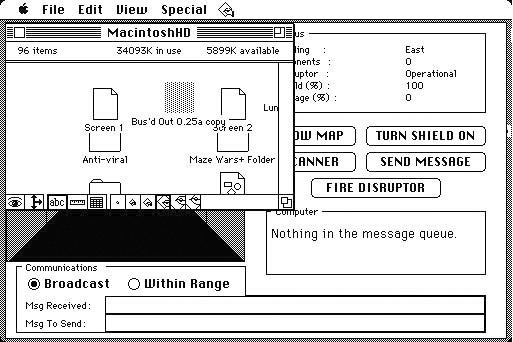|
|
|
|
|
|
|
Switcher
Before the MultiFinder, introduced in
System 7, there was Switcher and then Servant. The largest
benefit of the Macintosh 512K and the Macintosh Plus was the
additional memory available to users. However, it was still
impossible, under Macintosh System Software, to run multiple
applications at the same time. While information could be
Cut or Copied to the Clipboard, users would have to quit out
of MacPaint, for example, before opening MacWrite and
pasting in their graphic. Andy Hertzfeld's Switcher allowed
Macintosh 512K and Plus users to have multiple applications
open at the same time and to switch between these
applications, thus making their computer use more
productive. Servant was in development at the same
time as Switcher, and the features first developed for
Switcher made their way into Servant. However, while
Switcher was a little less intuitive in that users had to
first select the applications that they wanted to run
simultaneously then start switching, Servant allows users to
just start opening applications and immediately switch
between them. It must be noted, however, that unlike
Multi-Mac, Servant does not allow for true multitasking: the
foreground application dominates the use of the CPU, and
other applications must wait for the user to switch to them
before they utilize the CPU. Evidently the only true
multitasking support Andy Hertzfeld planned on adding to
Servant was support for background tasks such as printing,
and possibly support for background modem downloads.
Selecting Memory Configuration Information from the Special
menu provides the user with a graph of memory usage, as
shown below. Servant tracks the amount of memory
used by open applications as well as how much free memory is
left available for use. Servant assigns applications a set
amount of memory. In addition, Servant allows users to
configure the memory allocation for specific
applications. While MacPaint has only 128K assigned
to it, Servant allocates 448K for most applications. As
shown from the graph, 448K was generally enough for a
particular application. In the screenshot below Servant is the
foreground application and Bus'd Out is running the in the
background. The Servant menu allows easy switching between
applications. A user may also click on a background
application to bring it to the foreground. Additionally, the
key comination Apple-[ takes the user back to Servant no
matter which application is currently in the foreground.
Many original Macintosh applications tend to fill the entire
screen; Bus'd Out is a good example. For this reason the
menu is the easiest way to switch between
applications. With all this memory swapping and
hacking at the System level, one might question the
stability of applications that were not written with
switching in mind. Applications do hang or even crash when
running under Servant. Although it does not always work,
Apple-Option-Shift-period will force quit a hanging
application and leave the others running, if it does not
crash the Macintosh. However, I have had applications crash
and present the standard Macintosh system error dialog but
with a Resume button that actually works, bringing me back
to Servant and the other running applications. Typically,
however, the Macintosh locks up completely and has to be
restarted with the Programmer's Switch. As Andy Hertzfeld noted in the About
window, "Use it with caution, as it is still undergoing
testing."
![]()




copyright 2002 Josh
Burker all icons, names, and
trademarks are property of their respective
owners

